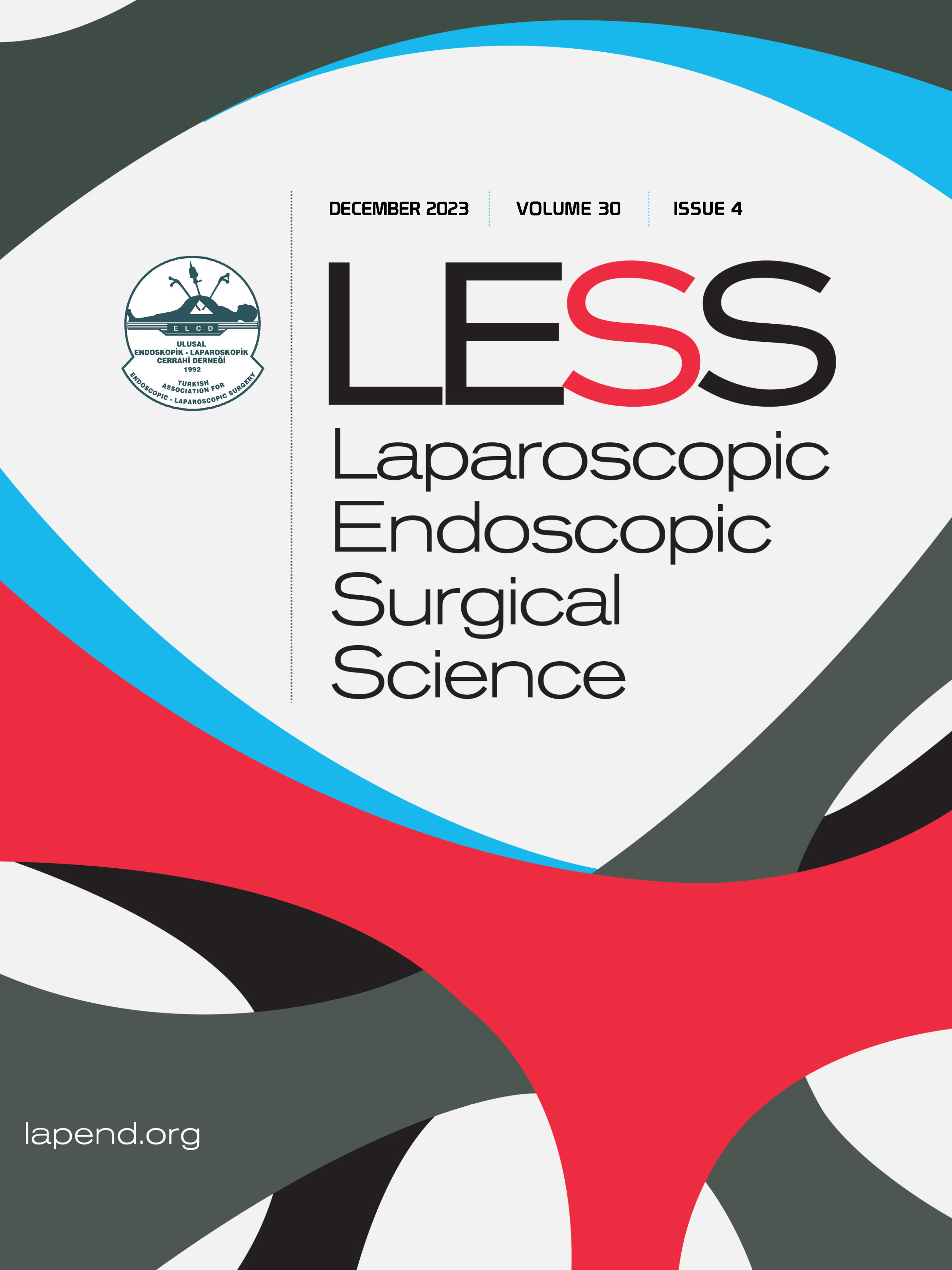Volume: 13 Issue: 2 - 2006
| RESEARCH ARTICLE | |
| 1. | In the treatment of the organ confined prostate cancer laparoscopic radical prostatectomy Tibet Erdoğru, Murat Uçar, Erdem Akkaya, Ahmet Şanlı, Orçun Çelik, Mehmet Baykara Pages 55 - 65 INTRODUCTION: Nowadays, laparoscopic radical prostatecomy (LRP) has been increasingly accepted providing similar function and oncological results as open radical prostatectomy in the treatment of organ confined prostat cancer. We analyzed the results of our first experience with LRP using Heilbronn technique. METHODS: The following parameters were evaluated: preoperatively body mass index and hemoglobin level, perioperatively operative time, estimated blood loss, transfusion rate, postoperatively duration and amount of analgesic treatment, catheterization time, perioperative morbidities and complications, oncologic status (surgical margin). Subsequently, functional result and oncological outcames on continence were also included in this analysis for 6 and 12 months postoperatively. RESULTS: We performed LRP in 70 patients with organ confined prostate cancer (mean age: 63.8±7.0 years). Pelvic lymphadenectomy and neuro-vascular bundle-sparing dissection were performed in 31.4 and 34.2 per cent of the patients, respectively. While mean urethro-vesical anastomosis time was 34.3±10.1, operative time including anastomosis was 222.9±64.5 minutes. Whilst the reduction in Hb level was 18.6%, blood transfusion rate was 18.5%. The mean hospitalisation and urethral catheterisation times were 4.5±2.0 and 10.6±5.4 days, respectively. In two patients postoperative re-intervention was required due to thermal effect of cautery on ileum and rectum, respectively. Surgical margin positivity was 7.4% and 45% in pT2 and pT3a groups. Continence rates were 81.5% and 92% at postoperative the 6th and 12nd months, respectively. DISCUSSION AND CONCLUSION: In our opinion the technique of laparoscopic prostatectomy is transferable without loss of operative quality depend on the concept of laparoscopic education. Taking this training concept into the consideration the learning curve will only include the operating time but not the number of complications or the functional and oncological results of this procedure. |
| 2. | The Role of Diagnostic Laparoscopy in Acute Right Lower Quadrant Pain Hüseyin Bakkaloğlu, Hakan Yanar, Korhan Taviloğlu, Cemalettin Ertekin, Recep Güloğlu, Fatih Yanar Pages 66 - 71 INTRODUCTION: In some cases, the origin of the complaint is not easily revealed even after getting the results of the examining tests of the patients who have applied to the emergency unit with acute right lower quadrant pain. While some patients are being discharged after obtaining clinical improvement, another group of patients are hospitalized for surgical intervention. In this study, results of diagnostic laparoscopy performed in nonspecifically selected patients with acute right lower quadrant pain of unknown cause are evaluated retrospectively. METHODS: From January 2002 to August 2005, in Istanbul Medical Faculty General Surgery Department, 93 patients undergone diagnostic laparoscopy for non traumatic acute right lower quadrant pain were evaluated retrospectively. After performing laboratory and imaging modalities, patients without findings to explain the origin of acute right lower quadrant pain were hospitalized for 24 hours. Following 24 hours of observation period, if no improvement was established both in laboratory and physical examination, diagnostic laparoscopy was done. RESULTS: Sixty patients were female (64.5%) and 33 were male (35.5% ). Age average was 27 years (16-67). Out of 93 patients, 61 were determined having acute apendicitis (65.6%) and underwent apendectomy. Ten patients had right ovarial pathology (10.8%), 6 had pelvic inflamatory disease (6.4%), 3 had adhesions in the terminal ileum (3.2%). In 13 patients (14%) no findings of abdominal pathology at diagnostic laparoscopy. DISCUSSION AND CONCLUSION: Diagnostic laparoscopy in acute right lower quadrant pain with no apparent cause is a highly valuable method for determination of the diagnosis and treatment modality. Diagnostic laparoscopy is a time sparing method for diagnosis and treatment, also limits the expenses of additional imaging modalities. Importantly, it reduces the morbidity in cases with perforation. This method has advantageous for time sparing in progressive diseases, reducing cost and diminishing the hospitalization period in comparison to laparotomy. |
| 3. | The Laparoscopic Repair of Morgagni's Hernia Umut Barbaros, Uğur Deveci, Tunç Eren, Burcu Tulumoğlu, Rıdvan Seven, Selçuk Mercan Pages 72 - 76 INTRODUCTION: Morgagni's hernias constitute about 3% of all diaphragmatic hernias. Despite a number of studies advocating thoracoscopic approaches, laparoscopic repair remains to be one of the best treatment methods. METHODS: We describe the placement of a double-layer mesh anchored by helicoidal staples to repair the hernia defect via laparoscopy. RESULTS: Her symptoms completely resolved postoperatively with no evidence of recurrence. DISCUSSION AND CONCLUSION: The laparoscopic repair should be considered as an effective and safe procedure for the treatment of Morgagni's hernias. |
| CASE REPORT | |
| 4. | Morgagni Hernisinin Laparoskopik Onarımı: Olgu Sunumu Umut Barbaros, Uğur Deveci, Tunç Eren, Burcu Tulumoğlu, Rıdvan Seven, Selçuk Mercan Pages 77 - 81 Morgagni's hernias constitute about 3% of all diaphragmatic hernias. Despite a number of studies advocating thoracoscopic approaches, laparoscopic repair remains to be one of the best treatment methods. We describe the placement of a double-layer mesh anchored by helicoidal staples to repair the hernia defect via laparoscopy. Her symptoms completely resolved postoperatively with no evidence of recurrence. The laparoscopic repair should be considered as an effective and safe procedure for the treatment of Morgagni's hernias. |
| 5. | Laparoscopic Repair of Morgagni Hernia and Diaphragmatic Eventration: Report of two Cases Koray Topgül, A. Ziya Anadol, Bülent Güngör Pages 82 - 88 Laparoscopic methods are widely used for all kinds of hernia repairs. Not only the abdominal wall defects but also rare forms of hernias are good candidates for laparoscopic surgery. In this report, we present the outcome of two adult patients with diaphragmatic hernia and elevation but no history of trauma treated laparoscopically with emphasis on its advantages since technically it is easier to perform, has a low infection rate, postoperative comfort, less pain and rapid return to normal activity. In addition, prosthetic materials should be used for repair and Composite mesh may be considered as the first choice for larger defects. |
| REVIEW | |
| 6. | Laparoscopic Gastric Stromal Tumor Resection Neşet Köksal, Ediz Altınlı, Ender Onur, Atilla Çelik, Aziz Sümer Pages 89 - 95 Gastric stromal tumors are rare neoplasm that may be benign or malignant. Most of the patients who have gastric stromal tumors are asymptomatic. Although surgery is mandatory for the symptomatic tumors, for small size and asymptomatic tumors it may be debatable. Both laparoscopic and open surgical procedures can be used for the treatment of gastric stromal tumors. Our aim is to discuss a case of gastric stromal tumor treated by laparoscopic gastric wedge resection. Renal cortical cyst and cholelithiasis were both treated simultaneously in the same patient by laparoscopic approach. |















